Moscow City Museum
 Bashny.Net
Bashny.Net
Attractions Moscow has underground Archaeological Museum on Moscow's Manezh Square. Before it closed a few months ago for the reconstruction, it was a good opportunity to plunge (literally) back centuries in the city, where every day is running out of genuine antiquity. Moscow Museum of Archaeology is located in an underground hall at a depth of 7 meters in the historic center of the city. The museum was opened in 1997, after the completion of large-scale excavations at the Manezhnaya Square during the construction of the shopping center Okhotny Ryad. The main exhibit of the museum - preserved foundations of the Resurrection of the bridge, once thrown over the river Neglinka, but personally for me there most fascinating layout of Moscow Ivan the Terrible, ie around the mid-16th century. While Moscow consisted of two cities: the Kremlin and China Town, which is surrounded by several planted in the borders of modern Garden Ring. On the model we can see China Town and the Kremlin in the background:

From Chinatown mid-16th century, it is now nothing left but a trace of streets and a genuine piece of the ramparts in 1530-ies. behind the hotel Metropol. Of course, if to excavate, it will be possible to find a lot of interesting and muzeifitsirovat. But as long as this is done only with the foundations of an ancient temple (in front of the monument to Ivan Fyodorov printing pioneer). That looked like the remains of the Resurrection of the bridge in 1996, when they were discovered during excavation works:

On the way to the Resurrection of the bridge began in Tver and then to St. Petersburg. Before it was built on the site existed a ferry. At the beginning of XVII century bridge was built, which was the first stone bridge in Moscow. It can be seen in the plans of Moscow of the XVII century. In 1740, instead of the old bridge has been erected by the architect P.Geydenom new white stone bridge. He was more than 100 meters in length and up to 30 meters in width. Since the bridge appeared in the mid-18th century:
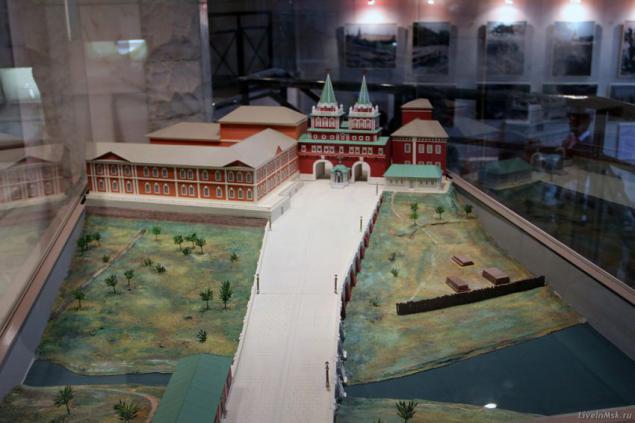
And this is how it looks in the museum:

Of the five arches of the bridge running it was only one - the right when viewed in the direction of the bridge from the gallery of the Museum. The design of the bridge is quite well preserved due to the fact that in the years 1817-19 in the reconstruction work following the war of 1812, the river Neglinka concluded pipe and Resurrection bridge superfluous asleep.

The Archaeological Museum is also a wonderful layout Manezhnaya Square in the 19th century when it was built shopping areas:
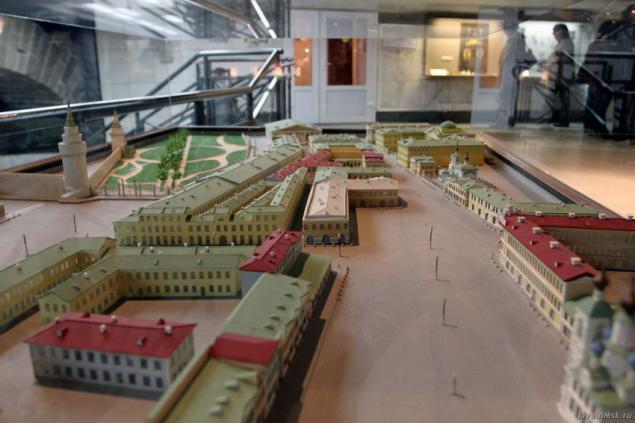
Other view:

All this building rolled under the asphalt in the early to mid-1930s. Reconstruction of the 17 th century image of Muscovites:

One of the exhibits of the museum is devoted to the ancient treasure found during archaeological excavations on the territory of Moscow. Muscovites ancient treasures hidden in the various ceramics or clay - jugs, pots, cups ... The first treasure, presented in the museum, was found in 1996 during excavations at the site of the old Gostiny Dvor, when clearing a log basement under the charred deck floor. Then, a copper jug was found covered with a copper bowl, which turned out to be 3 silver cups, 6 bowls of silver, 331 silver coin of Western Europe, 21 823 ancient silver coins. One and a half meters from this jug was found the second part of the treasure, preserved in a jar of white clay, shut up wooden stopper. Pitcher also contained a lot of discoveries: 3 silver cups, three silver cups, 4 silver euro coins and 73,606 silver ancient coins. Archaeologists have found that the treasure was hidden around the 40s of the XVII century.
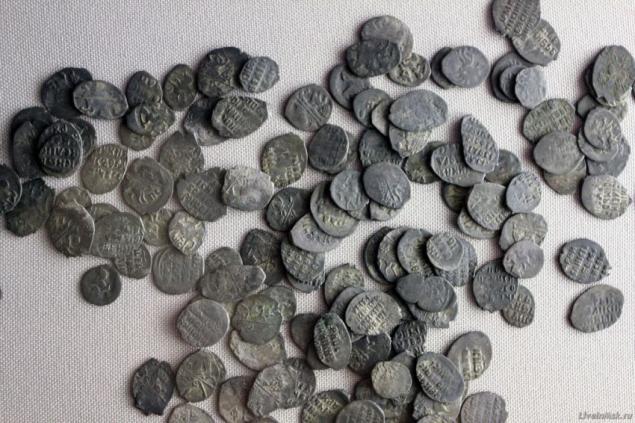
Excavations at the Manege Square On 20 April 1996 in the northern part of Gostiny Dvor near the street Ilinka when clearing deep log basement, under the charred logs, in holes, was found the largest Moscow treasure - 2 pitcher, copper and clay, where there were 16 silver vessels, 335 Western European coins - thaler second half beginning of XVI-XVII centuries. and 95,429 silver coins Russian.

There is no written evidence that would help to know the name of the owner of the treasure, but archaeologists still expressed some assumptions. Traces of fire suggests that a wooden building, in the basement which were hidden treasures, burned completely, and the owner could not be found in the ashes the place where he hid the money. It also suggested that found the treasure belonged to one person, and were not government property. Otherwise, the place of their storage would have known a few people, and the joint efforts of values could be found after the fire. In support of this we give the words spoken by foreign travelers on the Russian custom of hiding money: & quot; ... Russian do not trust even the closest relatives; many merchants, gain money trade, bury them in a place known to him alone, and die, for the most part, are not open to anyone & quot ;.
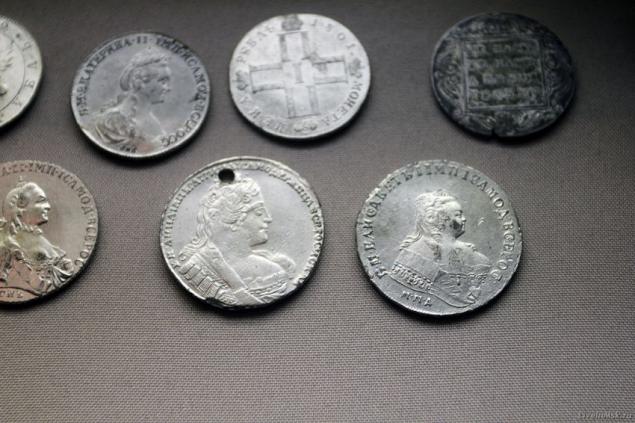
There exposure and Spanish treasure, so named because it contained a Spanish coin. This treasure was found in 1970 during archaeological work in the Ipatiev alley. Copper basin was filled with 3,397 silver coins of denomination 2, 4 and 8 reales, which related to the period of the following Spanish kings: Philip II, Philip III and Philip the Fourth (the beginning of XVI - the 30s of the XVII century). The treasure was probably in the 30 th years of the XVII century.
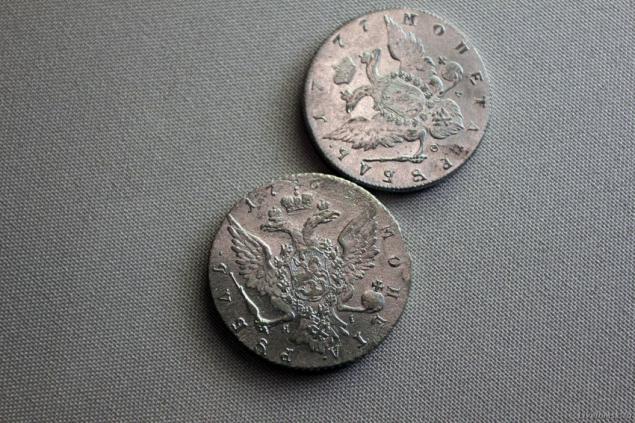
Vintage bottle - is also the subject of archaeological:
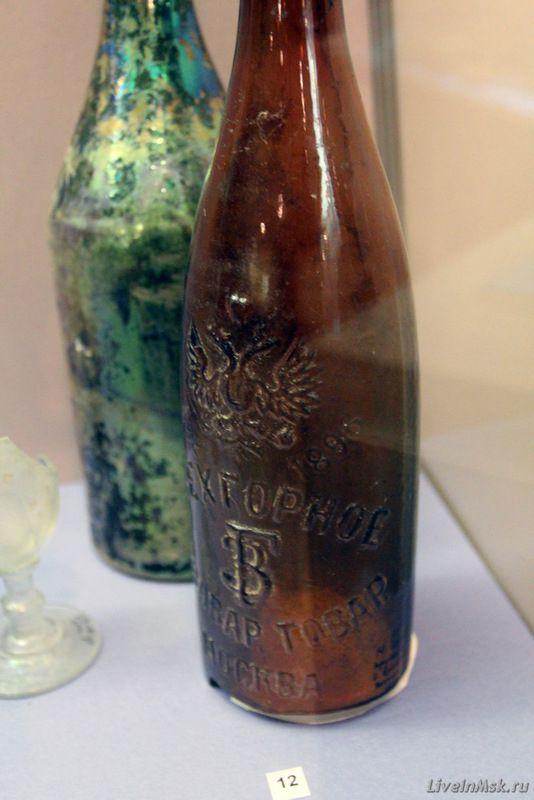
Source: visualhistory.livejournal.com

From Chinatown mid-16th century, it is now nothing left but a trace of streets and a genuine piece of the ramparts in 1530-ies. behind the hotel Metropol. Of course, if to excavate, it will be possible to find a lot of interesting and muzeifitsirovat. But as long as this is done only with the foundations of an ancient temple (in front of the monument to Ivan Fyodorov printing pioneer). That looked like the remains of the Resurrection of the bridge in 1996, when they were discovered during excavation works:

On the way to the Resurrection of the bridge began in Tver and then to St. Petersburg. Before it was built on the site existed a ferry. At the beginning of XVII century bridge was built, which was the first stone bridge in Moscow. It can be seen in the plans of Moscow of the XVII century. In 1740, instead of the old bridge has been erected by the architect P.Geydenom new white stone bridge. He was more than 100 meters in length and up to 30 meters in width. Since the bridge appeared in the mid-18th century:

And this is how it looks in the museum:

Of the five arches of the bridge running it was only one - the right when viewed in the direction of the bridge from the gallery of the Museum. The design of the bridge is quite well preserved due to the fact that in the years 1817-19 in the reconstruction work following the war of 1812, the river Neglinka concluded pipe and Resurrection bridge superfluous asleep.

The Archaeological Museum is also a wonderful layout Manezhnaya Square in the 19th century when it was built shopping areas:

Other view:

All this building rolled under the asphalt in the early to mid-1930s. Reconstruction of the 17 th century image of Muscovites:

One of the exhibits of the museum is devoted to the ancient treasure found during archaeological excavations on the territory of Moscow. Muscovites ancient treasures hidden in the various ceramics or clay - jugs, pots, cups ... The first treasure, presented in the museum, was found in 1996 during excavations at the site of the old Gostiny Dvor, when clearing a log basement under the charred deck floor. Then, a copper jug was found covered with a copper bowl, which turned out to be 3 silver cups, 6 bowls of silver, 331 silver coin of Western Europe, 21 823 ancient silver coins. One and a half meters from this jug was found the second part of the treasure, preserved in a jar of white clay, shut up wooden stopper. Pitcher also contained a lot of discoveries: 3 silver cups, three silver cups, 4 silver euro coins and 73,606 silver ancient coins. Archaeologists have found that the treasure was hidden around the 40s of the XVII century.

Excavations at the Manege Square On 20 April 1996 in the northern part of Gostiny Dvor near the street Ilinka when clearing deep log basement, under the charred logs, in holes, was found the largest Moscow treasure - 2 pitcher, copper and clay, where there were 16 silver vessels, 335 Western European coins - thaler second half beginning of XVI-XVII centuries. and 95,429 silver coins Russian.

There is no written evidence that would help to know the name of the owner of the treasure, but archaeologists still expressed some assumptions. Traces of fire suggests that a wooden building, in the basement which were hidden treasures, burned completely, and the owner could not be found in the ashes the place where he hid the money. It also suggested that found the treasure belonged to one person, and were not government property. Otherwise, the place of their storage would have known a few people, and the joint efforts of values could be found after the fire. In support of this we give the words spoken by foreign travelers on the Russian custom of hiding money: & quot; ... Russian do not trust even the closest relatives; many merchants, gain money trade, bury them in a place known to him alone, and die, for the most part, are not open to anyone & quot ;.

There exposure and Spanish treasure, so named because it contained a Spanish coin. This treasure was found in 1970 during archaeological work in the Ipatiev alley. Copper basin was filled with 3,397 silver coins of denomination 2, 4 and 8 reales, which related to the period of the following Spanish kings: Philip II, Philip III and Philip the Fourth (the beginning of XVI - the 30s of the XVII century). The treasure was probably in the 30 th years of the XVII century.

Vintage bottle - is also the subject of archaeological:

Source: visualhistory.livejournal.com
Tags
See also
Paid parking - the best thing that ever happened to Moscow
Top 20 tourist attractions of Barcelona
7 domestic and foreign stars, impress us with a variable in appearance
12 floors underground in the event of nuclear war ...
Unusual Petersburg's office
Mystical paintings
The car with the inscription "Medvedev"
The actual situation that happened the other day in Moscow!
Tonsils
Unusual office: So that I worked so!
















